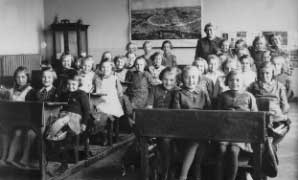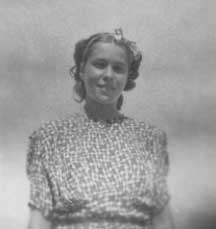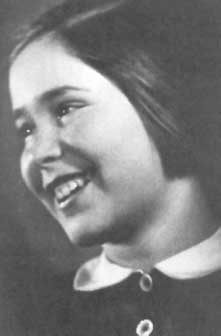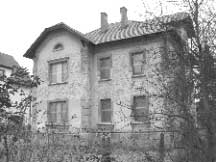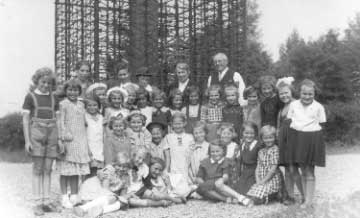The Story of Mother and Her Daughter
Anita Fischerová, whose married name was Franková, was born in Litomyšl on 13th July, 1930, daughter of Ela Fischerová, née Felixová, born on 23rd October, 1902 and Josef Fischer, a lawyer. Her parents met at a ball in Hradec Králové. They got married in 1929 and Ela, who had lived in Prague before their marriage, followed her husband to Litomyšl. They lived at what is today 532, Trstěnická Street. They had a small silver coloured Tatra car and a dog, a Scottish terrier. The dog was white and her name was Spotty.
Mr. Fischer opened an office at what is today 113, Smetana Square. He spoke perfect French, German and Latin. His main clients were farmers from the surrounding villages, mostly Germans.
When Anita was born, her parents employed a nurse to help with the little girl. Anita liked her very much and called her Maceška (a diminutive of the Czech word, macecha, meaning a step mother. By calling her nurse 'maceška' [pensy], Anita meant that the nurse was like a second mother to her, a kind of step-mother). When Anita was two years old, the nurse was replaced by a governess called Lenka.
The little girl was often "naughty becasue she didn't want to eat". As a birthday present, she once asked for permission not to eat for a whole day. Once though, she wanted to try the horse meat that the Skřivans baked in "their street" and which was considered a delicacy in the town. Lenka took Anita to the Skřivans´ and the little girl enjoyed her meal there. When her mother found out, it made her angry that Anita had eaten "bad food".
There was yet another person who belonged to the Fischer household - Ema. She came from a poor family in a village and she found a job at the Fischers. Soon she felt at home there and she got on well with the whole family. Sometime in 1938, she got married and moved away from Litomyšl. Ela and Anita got in touch with her after the war and they used to meet up until she died.
Mrs. Fischerová did not work. However, she did get up in the morning together with her husband and daughter and have breakfast with them, still dressed in her nightdress. Then she would go shopping and cook lunch with Ema. In the afternoon, she would go to meet her husband from his office.
Mrs. Franková has a lot of memories from the time she lived in Litomyšl. For example, she remembers a nearby shop called ´U Bradů´, where they had a cask of anchovies and customers were allowed to 'fish' for these delicacies in the cask. She also remembers her mother bringing a goose home and fattening it with rolls. She then baked the goose liver in lard. Mrs. Franková also remembers the taste of fried frogs legs and family outings to a nearby village called Nedošín, with a restaurant that had a tea garden where they served their guests trout.
It´s also impossible to forget the turkey kept by their neighbours. Little Anita was really scared of it. She had a red jacket which attracted the turkey, so it was always gobbled at her.
The Fischers had a lot of friends in Litomyšl - not only Jews. They used to go on trips with them and also to balls, theatre and fancy dress parties. They would always agree on the same theme and try to surprise one another with their special costumes. They went to play bridge and another card game called ´mariáš´ and they played tennis on the court behind Sokol Hall. Most often they got togther with the family of Mr. Bartoš, a dentist and with the Freys.
Although Ela only had a basic education, she was very clever and energetic. She liked sports and everything was a piece of cake for her. She taught Anita to swim in the old swimming-pool in the summer and to ski in winter. Josef could neither swim nor ski. He did play tennis really well though.
From time to time, Anita used to go to the cinema. She saw several films with Shirley Temple in and also a Disney film, 'Snow White and Seven Dwarfs'. She also had some children books that were very popular at the time, such as Fireflies, Old Czech Legends, Stories about a Little Dog and a Little Cat, and Dášeňka.
The Fishers went to synagogue on special occasions, for example the Jewish New Year and Reconciliation Day. They would take Anita with them. Mrs. Franková also remembers celebrating the Tora feast with a procession of children organized by the rabbi. Children walked round the synagogue waving Czechoslovakian flags. Finally, each of the children received a bag of sweets.
As a schoolgirl, Anita went to Jewish religion classes given by the rabbi and she liked to read Biblical Stories by Olbracht.
Like everyone else in Litomyšl, the Fischers celebrated Easter and Christmas. One of Mrs. Franková's memories is of her grandfather, who came to visit them unexpectedly at Christmas. She says her father hurried to hide the navivity scene on display. Her grandfather knew about the Christmas tree and did not mind, but her parents probably did not want to risk his anger with the nativity scene.
Every 28th October (Independence Day), there was a Chinese lantern parade. People walked round Sokol Hall and continued walking in the direction of Smetana´s House, in other words, across the whole town. The lanterns were decorated with pictures of President T.G. Masaryk. Anita remembers that once she cried because somebody had a "bigger Masaryk" than her.
When it was time for Anita to start first grade at basic school, she was supposed to have gone to the school near the castle becuase she lived nearby. Her friend. Eva Freyová, who lived in the opposite part of town, was supposed to have gone to the so-called training school in today´s Komenský Square. Anita was heartbroken and, since she would not stop crying, her mum, Ela, arranged for both girls to attend "Eva's" school. On the very first day they were naturally seated together, but this did not last long. Although they looked angelic, they kept nudging each other and trying to push each other of their chairs. Their teacher, Mr. Václav Morávek, soon split them up. Besides Eva, another friend of Anita's at that time was Bedřiška Čepelková. The girls' teacher in the second and third grades was Mrs. Benešová.
School was quite far away for Anita, but her father´s office was in the same direction and so they would walk together part of the way. He left her in what is today Smetana Square and Anita would go the rest of the way on her own. After classes, she often went with Eva to the Freys´ house, where she sometimes had lunch.
At the time of Mnichov, Mr. Fischer had a heart attack. The Litomyšl Jews started to talk about emigrating. Mrs. Markéta Freyová remembers her meeting with Mr. Fischer in the arcades. The same topic came up and he said, "Come on. The emigrants, they are all such adventurers. How do they know that they will be better off out there? That their lives will be a bed of roses? We should just wait it out here." He was a great optimist and also a patriot.
Then, the grafitti JUDE appeared on the wall of the house where he had his office and he started to receive fewer and fewer clients. After the establishment of the Protectorate, he could not work as an lawyer and so the family moved to their grandfather's in Rychnov nad Kněžnou. Anita used to go there for holiday so she had a lot of friends in Rychnov and got used to their new home very quickly. She also finished third grade there.
Mr. Fischer decided to train as a baker so he could support his family, but when more and more prohibitions were issued affecting Jews, it seemed better to him to get a job in a larger city. Ela had inherited a three-story house in Prague. The Fischers moved there towards the end of September, 1939. They had to part with Spotty. Anita remembers how much she cried about that.
That year, school started late, on 1st December in Prague. Anita entered the fourth grade, but soon after that, Josef Fischer had his second heart attack and died on 17th November, 1939. Anita was left alone with her mum.
On 30th July, 1942, both of them arrived at the meeting place in front of Veletržní Palace and on 3rd August, they left in AAW transport for Terezín. Anita was number 245 and Ela 244. Ela was looking forward to having some time to rest. She was exhausted by the long wait to be moved and the uncertainty. However, she did not know that they could be sent somewhere else after Terezín.
The ghetto was overcrowded by the time they arrived. About sixty thousand Jews lived there then. All the other inhabitants had already left the town.
Anita and her mum got off in Bohušovice and they loaded their 50kg of luggage onto a vehicle and finished their journey on foot. They never got their luggage back. First, they lived in the laundry room of a pub, sleeping on a brick floor. Then Anita was moved to the Dresden barracks, where all the children were sent against their will. Anita, who was an only child, was very close to her mum. It was difficult for Anita to face the situation and she cried a lot.
The food at Terezín was not very nice and there was never enough of it. In the morning, people got black coffee without sugar and at noon some soup and five or six small potatoes. Daily, they received 0.37 kg of bread and 0.2 of oleo margarine and, per week, 0.5 kg of sugar. The rations varied though according to the categories of the prisoners.
Adults had to work in the ghetto. At the beginning, everybody was given some kind of manual labor to do - sweeping, rearranging things or carrying all kinds of things from one place to another. After a while, work was assigned according to your profession or interests and on the basis of favouritism and good luck. Ela started to work as a nurse in a mental home. The children occasionally worked in the gardens when it was spring or summer. They quite liked going there as they had a chance to be outdoors and steal some food for themselves.
Soon after their arrival, Anita fell ill, as there was a scarlet fever epidemic. She had to stay in hospital for three months (until 18th December, 1942), first with scarlet fever and then with hepatitis and finally with problems with her heart.
When the little girl was better, she did not go back to the Dresden barracks but was sent to the ´heim´ (a home for children without parents, with childminders to look after the children). It was pretty good luck as parents who worked all day did not have time to take care of their children. For that reason, there was the heim where nannies would take care of them, trying to entertain the kids however they could. They even secretly provided education to the children. There was a lot of interest in the lessons, but there was not enough space for everyone. This was maybe one of the reasons why Anita was placed amongst girls who were a year younger. After a few years, she met her friend from Litomyšl, Eva Freyová, there.
People were being sent to other places from Terezín but the Germans still did not separate families at that time. Anita´s illness meant that her mum and her were not sent anywhere. Anita got well towards the end of January, 1943 and she entered ´šlojska´ (the first building where the newly arrived people were taken and where all their belongings were taken away from them) with her mum. But again, they did not leave. Luckily, the night before the the transport left, they were taken out of it.
On 18th December, 1943, however, the Germans crammed them and about fifty other people onto a little goods wagon. Anita remembers women crying, children screaming and men arguing with each other. After a journey lasting 36 hours, the train arrived at Auschwitz Birkenau.
They got there at night. The place was full of commotion and noise. People were chased out of the wagons and forced to put their luggage on the platform. Then they were taken to lorries and taken to the camp. It was surrounded by a barbed wire fence and by tall towers. They were crammed into two barracks, 2,500 people in each. It was only possible to stand, as there was nowhere to sit.
In the morning, the prisoners were taken to the showers. Before their shower, they had numbers tattooed on their arms. Anita was 72780 and her mum 72779. When they washed themselves, they were given old clothes to put on and they never saw their own clothes again.
Anita and Ela ended up in Birkenau, in section BIIb. The barracks were long, with a brick chimney in the centre. They stoked the stove from both sides but the barracks were not heated in winter. The prisoners were not allowed to sit on the chimney. They slept on triple-bunks and each of the three levels was designed for six people.
Ela enrolled as a nurse in Block 3. Anita, who was still a child, did not have to work. The situation was very bad as far as food was concerned. In the morning, they were given tea, then turnip soup for lunch and in the evening 30 dkg of bread and either 1 dkg of grease, a spoonful of jam or half a slice of salami. The quality and quantity of food was directly related to the fact that the Germans were losing the war.
In the spring of 1944, Ela and Anita went through a selection procedure to decide if they would be sent to a labour camp or stay at Auschwitz. Anita was 14 but her mum claimed she was older so she could leave, but Germans did not accept her. Her mum, though, managed somehow to persuade them to take both of them off the list of people being sent away.
When they went through the selection process again, Mengele was drunk. They were lucky. He selected them for labour and so they avoided the gas chamber.
On 2nd July, 1944, they moved to the camp opposite, Frauenlager Auschwitz, where they waited to be sent on. Anita caught pneumonia there, but her Czech doctor would not let her stay at hospital for more than ten days. On 18th July, 1944, Anita and Ela left Auschwitz for Stutthof.
The first labour transport was being prepared there. When the lists were made, women younger than 16 and older than 40 were singled out. Therefore, Ela said that Anita was 18 and that she was 38. They left for Dörbeck, where they were forced to dig trenches all day long. They were brought soup at noon but despite that, they were hungry all the time. That´s why they used to steal sugar beet from a nearby field.
On 1st September, 1944, the prisoners were transported to Guttau. Again, they were digging trenches, but this time they were supervised by some extremely evil members of the Hitlerjugend.
The camp was located on a meadow near a village. Food supplies were shrinking. Portions were only given out in the morning and in the evening. The only water available was in the brook, which froze over in winter. The women lived in large circular "tents" made of plywood. They slept on straw. They could not escape the terrible cold. Even the tents let in rain. They did not have any other clothes to change into. Head lice as well as lice in their clothes spread quickly among them.
Towards the end of October, Anita caught typhus and later also scabies. Her whole body - head, arms and legs - was covered with impetigo, a skin disease. Because her mum did not have any shoes, she was allowed to stay with her in the camp and take care of her.
On 19th January, 1945, the front line moved closer to the camp. Men from the SS gathered the women who were still able to walk and led them away to an unknown place. Only the ill stayed in the camp. Once, an SS man came to the "hospital" holding a syringe and claiming he was going to inject everyone with a drug against typhus. It was strychnine, a poison. Luckily, there was not enough of it for everybody. Among those who were left out was Anita.
The men from the SS wanted to shoot the women who were left. They led them towards a prepared grave. The women lagging behind were hit with gun butts and killed. As if by miracle, some prisoners from the sad procession survived. Among them were Anita and her mother. When the men from the SS escaped, they returned to camp where they lost consciousness because they had suffered severe head injuries.
On 21st January, the Russians arrived at the camp. They fed them, treated them with medicine and then put them up in a house which they had cleaned before. They also gave them new dresses. After a while, the Russians sent them to a hospital on the home-front for soldiers from the front line in Deutch-Eylau. Compared to Guttau, the hospital was paradise. Anita remembers working with her friend in the kitchen, where they peeled potatoes.
After a while, those whose health was better were asked to help near the front line. Those with poor health were taken further inland. Ela was weak and so she and Anita were transported deep into Russian territory, to a military hospital in Syzran After two weeks, they were sent to a civil hospital in Kuybishev. There, they were later offered, or rather forced, to work in a kolkhoz, a Soviet agricultural cooperative, but before anything else happened, both of them ended up in a suburb of Kuybishev at the end of August, 1945, in a labour camp for German prisoners, where they were also holding convicted Russians. Ela had to go to work with German prisoners.
Anita hated the Russians the same way she hated the Germans, because this yet another concentration camp which exhausted her mum mentally as well as physically. Also, the Russians manged to do what the Germans didn't - to separate mother and daughter.
Once, when Ela was at work in September, 1945, a man came up to Anita telling her she was going to be sent away with three other girls. Her mum found out about it when she returned from work, during the roll call when the soldier was getting ready to take Anita away. Anita was resisting because she didn't want to be separated from her mum, who also didn't want it to happen. But the man pulled out a gun, aimed it at Ela and forced mother and daughter apart.
Anita travelled with the girls for nearly five weeks to Frankfurt an der Oder and from there, having gone through a four-week quarantine, to Prague. She arrived there around mid-November, 1945.
For unknown reasons, Ela was still being held in Russia. Her brother applied to the Ministry of Foreign Affairs for her return. Anita even went to Minister Zdeněk Nejedlý in Litomyšl to ask him for help.
Ela Fischerová returned home on 7th March, 1946.
She lived with Anita in Prague, where Anita attended grammar school. She started to study in the fourth grade and was supposed to sit exams in subjects she had "missed". She had private classes every day after her lessons. It was hard work and she was often exhausted. Finally, she passed her exams. She also passed her school leaving exam, even if it was at a different grammar school. She later graduated from the Charles University's Faculty of Arts, where she studied history and archive studies.
Ela Fischerová died on 30th January, 1950, as a result of the head injuries she suffered in Guttau.
Anita got married in 1950 and gave birth to her daughter in 1956. She named her after her mum - Ela. Ela has a daughter Anička born in 1983. She is the only direct descendant of the of the Fisher and Felix families.
Štěpán Kotyza and Petr Tměj
Literature used for the period January 1943 - January 1945:
Fischerová, Ela, A Letter to a Friend, from The World Without Human Dimensions, Prague, 1991.
